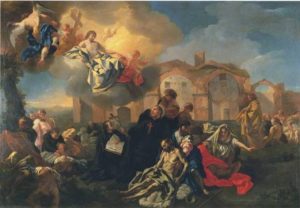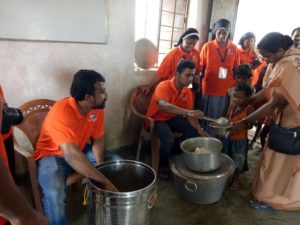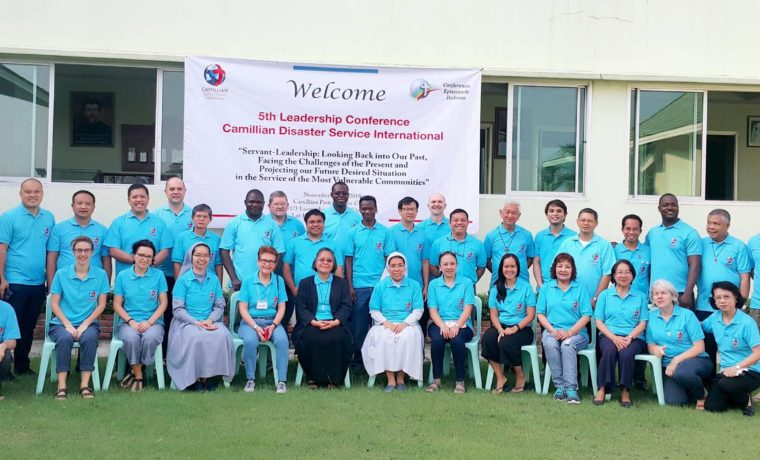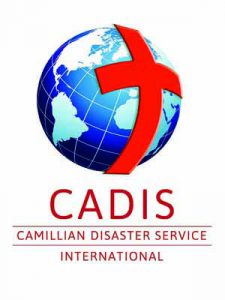Introduction
In this article I would like to manage to demonstrate how our presence through a multiplicity of forms and actions in response to natural and manmade disasters is a real expression of our charism and that in its implementation it allows the demands of totality of the fourth vow to be lived.
In the awareness that presence in the context of a disaster is a specific ministry, the CADIS Foundation, previously known as the Camillian Task Force, has evolved and developed its own pastoral practice. I will try to give an account of this through examples.
The Camillian Charism and Further Developments: CADIS
What allows us to define an experience as charismatic, the outcome that is to say of a charism, is the fact that it is rooted in history, takes a definite form, and is implemented through an ongoing group of persons who have adopted it; that it is a gift of Jesus Christ whose features it reflects with the broad kaleidoscope of his rich personality; that it is developed inside a changing historical context from which it draws challenges and stimuli in order to achieve renewed forms of ministry, remaining unaltered in its being but flexible in its work in response to the needs of the world; and that it takes place inside the Church, thereby contributing to the growth and the variety of the rich initiatives of the Church.
St. Camillus himself can be seen as the initiator of CADIS. The iconography of the sixteenth and seventeenth centuries allows us to argue in favour of the reasonableness of this statement. In the painting by Conca hung in the museum section of the House of St. Mary Magdalene we can see Camillus and his intention to come to the aid of the victims of the plague in Rome. Subleyras in his famous painting hung in the Museum of Rome, in contrary fashion, portrays Camillus engaged in saving the victims of one of the various floods of the Tiber, a cause of ruin and death for many people. The history of the foundation of the Order is marked by a specific recognition that plagues, floods and wars (the disasters of that epoch and not only of that epoch!) were an opportunity to live our charism with such a radical dedication that it was possible to put the fourth vow into practice. Some of the most dramatic, and at the same time most moving, pages of the history of the Order demonstrate the generosity shown by very many confreres who were able to give their lives in coming to the aid of the victims of disasters. In an interesting volume that discusses diakonia as the constitutive core of the Order, the author (Fr. E. Spogli, M.I.), after analysing the history of the Order of Camillians (a history that was not always edifying because of the inevitable human weaknesses), observes that disasters were able to reunite the Order and to renew in its individual religious awareness of our charism, stimulating them to engage in a competition of exemplary giving in order to make themselves ready to offer their service to the victims of disasters.
The charism as a gift to the Order comes from Christ whose merciful approach to the suffering it seeks to reproduce. Jesus reveals to every man a God who is a Father who is deeply inwardly merciful and suffers when His children suffer. Mercy is the real name of the Father, a characteristic that puts in a state of crisis theological visions that are structured around the performance of precepts and reward for those who are observant. God is the Father for all of His children and He awaits them with equal affection, without partiality or distinctions. This is  particularly true for those who are afflicted by physical, moral or spiritual suffering, towards whom He has feelings of privileged attention. To Camillus is attributed the phrase ‘do not tell me who you are, tell me what you have!’ This phrase echoes the approach of Jesus who did not offer explanations (‘Teacher who sinned, he or his parents, that he was born blind? Jn 9:2) or justifications (‘All of you were born in sin’, Jn 9:34a) for the drama of suffering but, instead, bent down over wounds and came to the help of people even when others tried to dissuade him from doing so because an illness had already run its course. Jesus also cared when faced with the weeping of a mother and widow who had lost her only child, without any prejudices or sectarianism, and without excluding the possibility that others, too, can perform miraculous deeds if the Father grants this. In his behaviour, Christ demonstrated what it means to have a Father who inwardly at a deep level is mercy: to have passion for every man, independently of his condition, social class, purity or impurity. Camillus adopted this message and demonstrated this with a dedication that overcame the barriers that were imposed by the dictates of the customs of his time, such as – for example – confession before any treatment or care was given. ‘Tell me what you have!’: this is what interested Camillus and this is what drove him on at the level of motivation.
particularly true for those who are afflicted by physical, moral or spiritual suffering, towards whom He has feelings of privileged attention. To Camillus is attributed the phrase ‘do not tell me who you are, tell me what you have!’ This phrase echoes the approach of Jesus who did not offer explanations (‘Teacher who sinned, he or his parents, that he was born blind? Jn 9:2) or justifications (‘All of you were born in sin’, Jn 9:34a) for the drama of suffering but, instead, bent down over wounds and came to the help of people even when others tried to dissuade him from doing so because an illness had already run its course. Jesus also cared when faced with the weeping of a mother and widow who had lost her only child, without any prejudices or sectarianism, and without excluding the possibility that others, too, can perform miraculous deeds if the Father grants this. In his behaviour, Christ demonstrated what it means to have a Father who inwardly at a deep level is mercy: to have passion for every man, independently of his condition, social class, purity or impurity. Camillus adopted this message and demonstrated this with a dedication that overcame the barriers that were imposed by the dictates of the customs of his time, such as – for example – confession before any treatment or care was given. ‘Tell me what you have!’: this is what interested Camillus and this is what drove him on at the level of motivation.
The charism given to Camillus is thus an awareness that we have to be a balsam of mercy for all suffering. Camillus well knew the sad condition of the sick in the hospitals of his epoch; he had experienced that condition personally. What changed the status quo was a group of people who – moved by love for Christ and his model – took responsibility for relieving the great deal of suffering that was to be found in hospital wards. However, suffering is especially evident where pain is without meaning to the utmost, more than where it is unjust, a matter of discrimination, and in many cases diabolical. Wars and disasters are an example of this because those who suffer because of them are always the poorest and the weakest and the way they are is always the outcome of unjust conditions of life against which these people have no protection. For this reason, the balsam of mercy cannot be held back in those conditions that most denounce the absence of God and call for His presence. Aware of all of this, starting with Camillus and continuing nowadays, the presence of the Order where there is an outbreak of war, in situations of devastation caused by nature, in ethnic conflicts, and where there are epidemics of disease, has been seen as a very high way of living the charism of mercy towards those who suffer, following the model of Jesus himself, the first to run to offer succour, to pour balsamic oil and to weep with those who weep.
 Our renewed Constitution speaks about our charism as the gift of ‘reliving’ the merciful love of Christ for the sick,[1] pointing not to a mere imitation but to an up-to-date experience embodied in concrete reality. Our charism is flexible, a gift that evolves, a gift that is not a carbon copy of the founding experience. It relives the spirit of this experience in forms that are always new and ones that are of contemporary relevance, to the point of accepting, as a natural event, that some institutions have to be let go if they have lost their meaning. The flexibility of our charism, despite its frailty, bears witness to its riches and perennial character: only that which knows how to change can continue to survive. In contrary fashion, what is rigid falls down with the blows of life. In accepting the future as a historical rule of development, CADIS helps to enrich the panorama of ministry and includes in it activities in favour of individuals and people who undergo the dramatic experience of pain, death, and the taking away of everything. CADIS makes itself the paladin of this care – which had already been present in the DNA of the Order, as we have seen above – and raises it to the level of ordinary ministry through animation and support, the promotion of correct strategies, the vision of a specific pastoral practice, the creation of dedicated offices and support for the good initiatives of the individual Provinces of the Order. In addition, CADIS has developed a holistic approach to suffering caused by disasters by recognising needs that go from prevention (disasters are a sign of intrinsic weakness and their impact is directly proportional to vulnerability: this means that it is not the case that each disaster has the same impact on the local population) to care for mental health (post- traumatic stress disorder is one of the most frequent symptoms in disasters and it is a symptom that is often underestimated). It is between these two poles that all of the operations of CADIS are located. Lastly, CADIS allows an organisation of acts of intervention that assures their continuity and their real effectiveness, as well as animating a wider participation inside the Order and the structures of the Church.
Our renewed Constitution speaks about our charism as the gift of ‘reliving’ the merciful love of Christ for the sick,[1] pointing not to a mere imitation but to an up-to-date experience embodied in concrete reality. Our charism is flexible, a gift that evolves, a gift that is not a carbon copy of the founding experience. It relives the spirit of this experience in forms that are always new and ones that are of contemporary relevance, to the point of accepting, as a natural event, that some institutions have to be let go if they have lost their meaning. The flexibility of our charism, despite its frailty, bears witness to its riches and perennial character: only that which knows how to change can continue to survive. In contrary fashion, what is rigid falls down with the blows of life. In accepting the future as a historical rule of development, CADIS helps to enrich the panorama of ministry and includes in it activities in favour of individuals and people who undergo the dramatic experience of pain, death, and the taking away of everything. CADIS makes itself the paladin of this care – which had already been present in the DNA of the Order, as we have seen above – and raises it to the level of ordinary ministry through animation and support, the promotion of correct strategies, the vision of a specific pastoral practice, the creation of dedicated offices and support for the good initiatives of the individual Provinces of the Order. In addition, CADIS has developed a holistic approach to suffering caused by disasters by recognising needs that go from prevention (disasters are a sign of intrinsic weakness and their impact is directly proportional to vulnerability: this means that it is not the case that each disaster has the same impact on the local population) to care for mental health (post- traumatic stress disorder is one of the most frequent symptoms in disasters and it is a symptom that is often underestimated). It is between these two poles that all of the operations of CADIS are located. Lastly, CADIS allows an organisation of acts of intervention that assures their continuity and their real effectiveness, as well as animating a wider participation inside the Order and the structures of the Church.
[1]Article 1 of our Constitution, adding to the previous article 1 which only referred to witness, observes that a specific feature of the charism is ‘the gift of reliving the ever-present merciful love of Christ for the sick and bearing witness to it to the world’.
















Camillians on Facebook
Camillians on Twitter
Camillians on Instagram